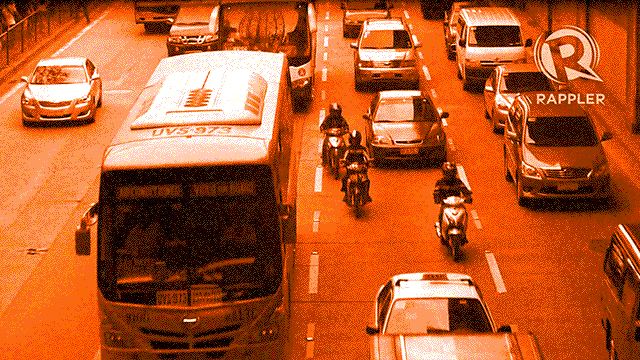SUMMARY
This is AI generated summarization, which may have errors. For context, always refer to the full article.

MANILA, Philippines – Is the Land Transportation Franchising Regulatory Board (LTFRB) to blame for the horrendous traffic in Metro Manila?
Two legislators – Senator Miriam Defensor Santiago and Valenzuela Representative Sherwin Gatchalian – want to look into the legality of the agency’s recent memorandum circulars, which they say have adversely affected traffic in the national capital region.
Recently, the board issued memorandum circulars 2014-009 and 2014-010. The first prevents traffic law enforcers’ operations against “colorum” public utility buses (PUBs); the second allows PUBs to change their routes and pass through the metro’s major roads.
Both Santiago and Gatchalian filed resolutions to begin a probe into the legality of the circulars.
“The suspension of operations against the out-of-line buses would only legalize and spur the proliferation of unauthorized vehicles, which is inimical to the country’s economic development,” said Santiago in a statement issued Monday, August 4.
But the LTFRB defended its memorandum, saying it would not add to the number of provincial buses already plying EDSA. The issuance of the memorandum is part of the “road rationalization” plan, which will “audit” existing public transport routes.
“With this rationalization of routes, we will be able to solve the out-of-line issues that have been illegally practiced by some PUB operators. Our roads will be better organized for the safety and convenience of the public,” LTFRB Chairman Winston Ginez earlier said.
Contrary to Aquino’s plans?
In a separate statement, congressman Gatchalian said the circulars “contradict the 2011-2016 Philippine Development Plan (PDP) of the Aquino administration that aims to establish an efficient, reliable, seamless, and integrated transport system/network.”
Memorandum circular 2014-009 protects “out-of-line” vehicles, or those that operate outside of approved routes, from heavy fines and sanctions. The fines and sanctions were earlier set in a June 3 joint administrative order by the LTFRB, the Land Transportation Office, and the Transportation department.
“In order to efficiently enforce and judiciously adjudicate out-of-line violations, the board will conduct a rationalization of current authorized route structures,” the LTFRB said in the circular. The rationalization began on June 19 and will end on October 17, 2014.
Under the rationalization program, the LTFRB will not issue new Certificates of Public Convenience to operators. They will, however, be allowed to file petitions for the possible amendment of existing routes.
Operators also need to keep its own passengers terminal or common passengers bus terminals should they propose new routes.
But the two lawmakers pointed out that the circulars contradict an order issued by President Benigno Aquino III. Executive Order No. 67, Series of 2012, pushes for the development of an Integrated Transport System.
One of the integrated transport terminals has since been opened in Paranaque.
“These issuances also defeat the purpose of the establishment of the Integrated Transport System to decongest traffic in Metro Manila and to restrict provincial buses and other unauthorized public utility vehicles from entering EDSA,” said Santiago.
Trucks, too
Santiago and Gatchalian aren’t the first to criticize the LTFRB for its circulars. The Metropolitan Manila Development Authority (MMDA) also assailed the board, blaming it for the traffic gridlock along Katipunan Avenue.
In a statement, MMDA Chairman Francis Tolentino said heavy traffic along the major road is the “ill-fated outcome” of another memorandum which imposed a “no-apprehension” policy on trucks-for-hire with green plates.
An earlier LTFRB memorandum barred operations against trucks from June 28 to July 28, but this has since been extended for 30 more days.
The LTFRB downplayed the MMDA’s data, saying the memo did not interfere with the MMDA’s existing truck ban and that it did not add to the number of trucks already traversing Metro Manila’s major roads.
“[The] LTFRB’s logic escapes me. Allowing these trucks to ply our roads when they are still securing the necessary paperwork in the name of trade and commerce is a flimsy excuse. This is LTFRB’ failing in their basic regulatory functions,” Santiago said in her statement.
Santiago and Gatchalian’s statements were released the same day an accident involving a truck along C5 road reduced the Philippine capital’s already-heavy traffic into an even slower crawl. – Rappler.com
Add a comment
How does this make you feel?
There are no comments yet. Add your comment to start the conversation.